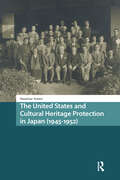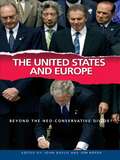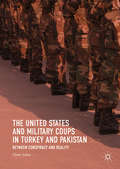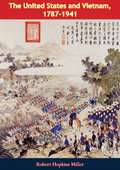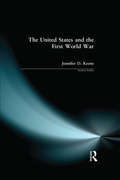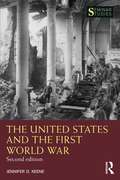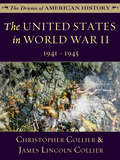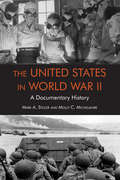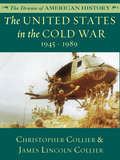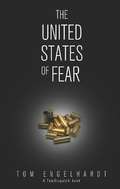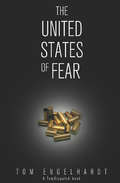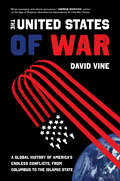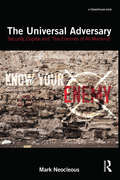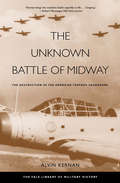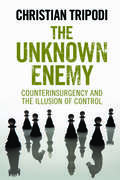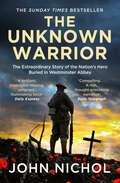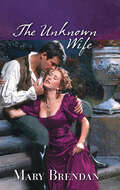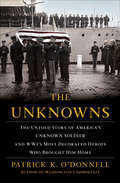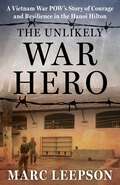- Table View
- List View
The United States and Cultural Heritage Protection in Japan (Asian History)
by Nassrine AzimiOne of the untold stories of the American military occupation of Japan, from 1945 to 1952, is that of efforts by the Arts and Monuments Division of the Supreme Commander for the Allied Powers (SCAP), for the preservation of Japan’s cultural heritage. While the role of Allies after WWII in salvaging the cultural heritage of Europe has recently become better known, not much is written of the extraordinary vision, planning and endeavors by curators and art specialists embedded in the US military and later based in Tokyo, and their peers and political masters back in Washington D.C. - all of whom ensured that defeated Japan’s cultural heritage was protected in the chaos and misery of post-war years.
The United States and Europe: Beyond the Neo-Conservative Divide? (Contemporary Security Studies)
by Jon Roper John BaylisA penetrating new examination of the triangular political and cultural relationship between America, Britain, and continental Europe. This relationship is both fraught and dynamic. Post-war reconstruction of Europe brought integration. Creating a ‘United States of Europe’ was a goal shared by many Americans. Yet the contemporary 'War on Terror', has redefined relationships between America, Britain, 'old' and 'new' Europe. For Britain, the Channel seems wider than the Atlantic, although geopolitically it is part of Europe. This book brings together experts from Britain, Europe and America to explore the complexities of contemporary cultural and political relationships, considering the challenges that have been met and those that have to be faced.
The United States and Military Coups in Turkey and Pakistan: Between Conspiracy and Reality
by Ömer AslanThis comparative study explores the involvement of the United States in four successful military coups in Turkey and Pakistan during the Cold War. Focusing on military-to-military relations with the US in each country, the book offers insight into how external actors can impact the outcomes of coups, particularly through socialization via military training, education, and international organizations such as NATO. Drawing upon recently declassified government documents and a trove of unexplored interviews with high-ranking officials, Ömer Aslan also examines how coup plotters in both countries approached the issue of US reaction before, during, and after their coups. As armed forces have continued to make and unmake Turkish and Pakistani governments well into the twenty-first century, this volume offers original, probing analysis of the circumstances which make coups possible.
The United States and Vietnam, 1787-1941
by Robert Hopkins MillerAs efforts continue to settle the Cambodia-Laos issue, Vietnam is again a focus of American attention. With the passage of time since the United States pulled out of Vietnam, American policymakers have begun approaching the major Indochinese issues from new perspectives, particularly new perspectives toward that general region. As is so often the case, history, by informing, may also help illuminate these issues. In this book, Ambassador Robert Hopkins Miller, a diplomat with considerable experience in Southeast Asia, presents the early history of US-Vietnam relations. In 1787, President Thomas Jefferson first showed an interest in the region—then called Cochinchina—for the purpose of trading for rice. From this beginning, Miller traces the ebb and flow of US diplomatic, economic, and strategic interests in Vietnam. Amply illustrated with excerpts from contemporary correspondence and official documents, the research shows Vietnam's intricate relationship with China, the gradually increasing commercial involvement of the Western powers, and the impact of Japan's expansionist policy. The chapters building up to World War II are particularly informative as they demonstrate, among other matters, the responsibility of national leaders to identify unambiguous political aims. In documenting the early development of US-Vietnam relations, the author has provided a service for historians and contemporary analysts alike. In presenting the long view of historical perspective, Ambassador Miller has enhanced our understanding of this area of the world. J. A. Baldwin Vice Admiral, US Navy President, National Defense University
The United States and the First World War (Seminar Studies)
by Jennifer D. KeeneThe First World War was a pivotal event in world history, but Americans often overlook the importance of their participation in the war. The United States and the First World War provides a concise, comprehensive and engaging evaluation of the war's significance in American history by examining the causes of the war, mobilization on the homefront, key social reforms enacted during the war, military strategy, the experiences of soldiers, the Versailles Peace Treaty, and the lessons Americans drew in the postwar years from their wartime experiences. Was the First World War a just war for the United States? This lively and interesting guide, full of maps and key primary source documents gives students the resources they need to grapple with this important question, and also to analyze how the war changed millions of American lives.
The United States and the First World War (Seminar Studies)
by Jennifer D. KeeneNow in its second edition, The United States and the First World War draws on the most recent scholarship to examine the significance of the First World War in American history. Written in a lively style that brings the era and historical actors alive, this concise and accessible text gives students the resources they need to grapple with the important question of how the conflict revolutionized the American way of war in the twentieth century. It examines the causes of the war, mobilization of the homefront, and key social reforms of the time, as well as military strategy, the experiences of soldiers, and the Versailles Peace Treaty. Jennifer D. Keene touches on social justice movements that were energized by the war; movements led by female suffragists, temperance advocates, civil rights activists, and Progressives pressing to make America safe for democracy. This new edition includes an expanded discussion of humanitarianism, the African American experience, and the impact of the influenza pandemic of 1918-19. New primary documents and four detailed maps provide students with additional context for this pivotal time in history. This book will be of interest to students and scholars of modern American history, American military history, and U.S. Foreign Relations.
The United States and the Vietnam War, 1954-1975: A Selected Annotated Bibliography of English-Language Sources (Routledge Research Guides to American Military Studies)
by Louis PeakeThe United States in the Vietnam War, 1954-1975 is an invaluable reference guide to the costly and controversial war the U.S. waged in Vietnam, over the course of five presidential administrations. Focusing not only on the conflict in Southeast Asia, but also on the tumult the war inspired on the domestic front, Louis Peake provides an authoritative guide to the wide range of media available on the U.S. involvement in Vietnam. From collections of art work and poetry about the soldiering experience, to journalistic accounts of battles, and military training films, the entries consistently provide clear and concise descriptions, allowing the reader to easily identify the value of any particular resource. With revised and updated annotations, and over 150 new entries, this second edition of The United States in the Vietnam War, 1954-1975 is an invaluable reference tool for researchers and students of the Vietnam War. Routledge Research Guides to American Military Studies provide concise, annotated bibliographies to the major areas and events in American military history. With the inclusion of brief critical annotations after each entry, the student and researcher can easily assess the utility of each bibliographic source and evaluate the abundance of resources available with ease and efficiency. Comprehensive, concise, and current—Routledge Research Guides to American Military Studies are an essential research tool for any historian.
The United States in World War II: 1941 - 1945
by James Lincoln Collier Christopher CollierHistory is dramatic -- and the renowned, award-winning authors Christopher Collier and James Lincoln Collier demonstrate this in a compelling series aimed at young readers. Covering American history from the founding of Jamestown through present day, these volumes explore far beyond the dates and events of a historical chronicle to present a moving illumination of the ideas, opinions, attitudes and tribulations that led to the birth of this great nation. The United States in World War II gives a history the years 1941 through 1945 from an American perspective. The authors discuss some of the ways the first World War led into the second, the events that drew the U.S. into the fighting, and the political, social, and economic effects of the war on our country. The text is enhanced with maps, photographs, and images of historic art.
The United States in World War II: A Documentary History
by Mark Stoler Molly Michelmore"Outstanding . . . the best short history I have read of America’s role in World War II. Stoler and Michelmore draw on a judicious selection of historical documents to provide a concise, readable history. The historiography of the war is well covered and explained. It is no small task to delineate the many, sometimes, heated debates over the conduct of the war, and in this volume the many sides of the historical debate are fairly and evenly treated. For a single-volume study, the book is remarkably comprehensive. It addresses major events and decisions; yet it also covers the political and policy-driven, strategic and operational, and social and cultural aspects of the War. The development of key technologies (such as the atomic bomb) and intelligence capabilities are explained. Finally, this book also covers topics that are often neglected in histories of the War, including racism in America, the American response to the Holocaust, and the evolving role of women in the workforce." —Adrian Lewis, The University of Kansas, author of The American Culture of War: The History of U.S. Military Forces from World War II to Operation Enduring Freedom (Routledge, 2nd ed. 2012)
The United States in the Cold War: 1945 - 1989
by James Lincoln Collier Christopher CollierHistory is dramatic -- and the renowned, award-winning authors Christopher Collier and James Lincoln Collier demonstrate this in a compelling series aimed at young readers. Covering American history from the founding of Jamestown through present day, these volumes explore far beyond the dates and events of a historical chronicle to present a moving illumination of the ideas, opinions, attitudes and tribulations that led to the birth of this great nation. The United States in the Cold War examines the history of the United States from 1945 to 1989. Beginning with the effects of World War II, the narrative follows the Korean War, the Vietnam War, and the rise and fall of Communism. The text is enhanced with maps, photographs, political cartoons, and other historically significant images.
The United States of America and the Crime of Aggression
by Giulia PecorellaThis book traces the position of the United States of America on aggression, beginning with the Declaration of Independence up to 2020, covering the four years of the Trump Administration. The decision of the Assembly of States Parties to the International Criminal Court to activate the Court’s jurisdiction over the crime of aggression in 2018 has added further value to a book concerning the position and practice of one of the most influential states, a global military power and permanent member of the UN Security Council. Organized along chronological lines, the work examines whether, or to what extent, the US position has evolved over time. The book explores how the definition of the crime can impact upon the US, notwithstanding its failure to ratify the Rome Statute. It also shows that the US practice and opinio iuris about the law applicable to the use of force might influence, as it has done in the past, the law itself. The work will be a valuable guide for students, academics and professionals with an interest in International Criminal Law.
The United States of Fear
by Tom EngelhardtIn 2008, when the U.S. National Intelligence Council issued its latest report meant for the administration of newly elected President Barack Obama, it predicted that the planet's "sole superpower" would suffer a modest decline and a soft landing fifteen years hence. In his new book The United States of Fear, Tom Engelhardt makes clear that Americans should don their crash helmets and buckle their seat belts, because the United States is on the path to a major decline at a startling speed. Engelhardt offers a savage anatomy of how successive administrations in Washington took the "Soviet path"--pouring American treasure into the military, war, and national security--and so helped drive their country off the nearest cliff. This is the startling tale of how fear was profitably shot into the national bloodstream, how the country-gripped by terror fantasies-was locked down, and how a brain-dead Washington elite fiddled (and profited) while America quietly burned. Think of it as the story of how the Cold War really ended, with the triumphalist "sole superpower" of 1991 heading slowly for the same exit through which the Soviet Union left the stage twenty years earlier.
The United States of Fear (TomDispatch Books)
by Tom EngelhardtThe creator of TomDispatch.com &“focuses on the specific absurdities of American wars . . . strident, passionate, and problem-solving&” (Mother Jones). In 2008, when the US National Intelligence Council issued its latest report meant for the administration of newly elected president Barack Obama, it predicted that the planet&’s &“sole superpower&” would suffer a modest decline and a soft landing fifteen years hence. In his new book, The United States of Fear, Tom Engelhardt makes clear that Americans should don their crash helmets and buckle their seat belts, because the United States is on the path to a major decline at a startling speed. Engelhardt offers a savage anatomy of how successive administrations in Washington took the &“Soviet path&”—pouring American treasure into the military, war, and national security—and so helped drive their country off the nearest cliff. This is the startling tale of how fear was profitably shot into the national bloodstream, how the country—gripped by terror fantasies—was locked down, and how a brain-dead Washington elite fiddled (and profited) while America quietly burned. Praise for Tom Engelhardt and The United States of Fear &“Engelhardt is absorbing and provocative. Everything he writes is of a satisfyingly congruent piece.&” —The New York Times &“A politician&’s worst nightmare.&” —Mother Jones &“Tom Engelhardt is the I. F. Stone of the post-9/11 age.&” —Andrew J. Bacevich, New York Times–bestselling author &“Tom Engelhardt, as always, focuses his laser-like intelligence on a core problem that the media avoid . . . A stunning polemic.&” —Mike Davis, author of Ecology of Fear and The Monster at Our Door
The United States of War: A Global History of America's Endless Conflicts, from Columbus to the Islamic State (California Series in Public Anthropology #48)
by David VineThe United States has been fighting wars constantly since invading Afghanistan in 2001. This nonstop warfare is far less exceptional than it might seem: the United States has been at war or has invaded other countries almost every year since independence. In The United States of War, David Vine traces this pattern of bloody conflict from Columbus’s 1494 arrival in Guantanamo Bay through the 250-year expansion of a global US empire. Drawing on historical and firsthand anthropological research in fourteen countries and territories, The United States of War demonstrates how US leaders across generations have locked the United States in a self-perpetuating system of permanent war by constructing the world’s largest-ever collection of foreign military bases—a global matrix that has made offensive interventionist wars more likely. Beyond exposing the profit-making desires, political interests, racism, and toxic masculinity underlying the country’s relationship to war and empire, The United States of War shows how the long history of U.S. military expansion shapes our daily lives, from today’s multi-trillion–dollar wars to the pervasiveness of violence and militarism in everyday U.S. life. The book concludes by confronting the catastrophic toll of American wars—which have left millions dead, wounded, and displaced—while offering proposals for how we can end the fighting.
The United States, It's Past, Purpose, and Promise
by Diane HartThe United States, It's Past, Purpose, and Promise by Diane Hart.
The Universal Adversary: Security, Capital and 'The Enemies of All Mankind'
by Mark NeocleousThe history of bourgeois modernity is a history of the Enemy. This book is a radical exploration of an Enemy that has recently emerged from within security documents released by the US security state: the Universal Adversary. The Universal Adversary is now central to emergency planning in general and, more specifically, to security preparations for future attacks. But an attack from who, or what? This book – the first to appear on the topic – shows how the concept of the Universal Adversary draws on several key figures in the history of ideas, said to pose a threat to state power and capital accumulation. Within the Universal Adversary there lies the problem not just of the ‘terrorist’ but, more generally, of the ‘subversive’, and what the emergency planning documents refer to as the ‘disgruntled worker’. This reference reveals the conjoined power of the contemporary mobilisation of security and the defence of capital. But it also reveals much more. Taking the figure of the disgruntled worker as its starting point, the book introduces some of this worker’s close cousins – figures often regarded not simply as a threat to security and capital but as nothing less than the Enemy of all Mankind: the Zombie, the Devil and the Pirate. In situating these figures of enmity within debates about security and capital, the book engages an extraordinary variety of issues that now comprise a contemporary politics of security. From crowd control to contagion, from the witch-hunt to the apocalypse, from pigs to intellectual property, this book provides a compelling analysis of the ways in which security and capital are organized against nothing less than the ‘Enemies of all Mankind’.
The University at War, 1914-25: Britain, France, and the United States
by T. IrishDrawing on examples from Britain, France, and the United States, this book examines how scholars and scholarship found themselves mobilized to solve many problems created by modern warfare in World War I, and the many consequences of this for higher education which have lasted almost a century.
The Unknown Battle of Midway: The Destruction of the American Torpedo Squadrons (The Yale Library of Military History)
by Alvin Kernan&“A memoir and more . . . Kernan brings this maritime battle superbly to life. . . . And he narrates the air assault in gripping detail&” (The Wall Street Journal). The Battle of Midway is considered the greatest US naval victory, but behind the luster is the devastation of the American torpedo squadrons. Of the 51 planes sent to attack Japanese carriers only 7 returned, and of the 127 aircrew only 29 survived. Not a single torpedo hit its target. A story of avoidable mistakes and flawed planning, The Unknown Battle of Midway reveals the enormous failures that led to the destruction of four torpedo squadrons but were omitted from official naval reports: the planes that ran out of gas, the torpedoes that didn&’t work, the pilots who had never dropped torpedoes, and the breakdown of the attack plan. Alvin Kernan, who was present at the battle, has written a troubling but persuasive analysis of these and other little-publicized aspects of this great battle. The standard navy tactics for carrier warfare are revealed in tragic contrast to the actual conduct of the battle and the after-action reports of the ships and squadrons involved. &“An incisive and laconic writer, Kernan knows his facts and presents them with deep feeling. A World War II must-read.&” —Booklist &“I read The Unknown Battle of Midway in one sitting. It is a momentous piece of work, reeking of the authenticity of carrier warfare as experienced by the flight crews.&” —Sir John Keegan, author of A History of Warfare &“An emotionally powerful story, not merely one of war but of its lasting effects.&” —The Times Literary Supplement
The Unknown Enemy: Counterinsurgency and the Illusion of Control
by Christian TripodiWestern counterinsurgency doctrine proposes that cultural intelligence is an important requirement for those forces operating amidst the unfamiliar socio-political structures often found in distant conflict zones. Yet while the determination to understand the intricate nature of alien societies may appear a rational undertaking in such circumstances, Christian Tripodi argues that these endeavours rarely help deliver success. The frictions of war and the complex human, cultural and political 'terrain' of the operating environment render such efforts highly problematic. In their attempts to generate and instrumentalize local knowledge for the purpose of exerting influence and control, western military actors are drawn into the unwelcome realm of counterinsurgency as a form of political warfare. Their operating environment now becomes a space charged with phenomena that they rarely comprehend, rarely even see and which they struggle to exert any meaningful control over. All in pursuit of a victory that might literally mean nothing.
The Unknown Internment: An Oral History of the Relocation of Italian Americans during World War II
by Stephen FoxFox combines extensive interviews with internees with research of government files and newspaper accounts to tell the little-known story of the 1942 forced relocation of Italian aliens from California to "safe zones".
The Unknown Soldier
by Jess M. BrallierThis moving tribute to veterans and America&’s fallen follows a young boy on his first trip to the Tomb of the Unknown Soldier.On the last day of their Washington, DC, vacation, Jack and his family visit a cemetery. Jack finds it boring, but as they watch the guard patrolling the Tomb of the Unknown Soldier, his perspective shifts. He learns about the monument, the sentinels, and why it is they keep watch. Jack develops a newfound respect for those who serve and an appreciation for the honor and bravery of veterans. Includes back matter about the Tomb of the Unknown Soldier and those who guard it.
The Unknown Warrior: A Personal Journey of Discovery and Remembrance
by John Nichol&‘Compelling… [Nichol has a] terrific eye for detail; an ability to blend tear-jerking letters, quotation and personal anecdotes into a rich, thought-provoking narrative&’Daily Telegraph Over one million British Empire soldiers were killed during the First World War. More than a century later, over half a million still have no known grave. The scale of the fighting, the catastrophic destruction, the relentless military engagement and glutinous mud meant that many of the dead were never identified, of often, never recovered. Names were left without bodies, and bodies, or fragments of bodies, without names. To help staunch the tide of national grief in the aftermath of the conflict, an idea was born for a single 'Unknown Warrior' representing all the missing, to be brought from the battlefields and buried in Westminster Abbey alongside the nation's kings and queens. Using diaries, archives and interviews with the descendants of that generation and modern-day experts, Sunday Times bestselling author and former RAF Tornado navigator John Nichol draws on his own experience of combat and loss to shine light on this 100-year-old story. And in speaking to those who have lost loved ones in more modern conflicts, he examines our continuing need for a tangible resting place at which to truly grieve the fallen. His search for answers becomes a moving and personal journey, exploring the true meaning of camaraderie, service, sacrifice and remembrance.
The Unknown Wife (Regency Ser. #46)
by Mary BrendanA rake’s foolishness may cost him his freedom—and his heart—in this Regency romance.A single passionate night’s encounter, long ago, has come back to haunt Colonel Etienne Hauke. He has a son—by a disgraced Society beauty who demands that Etienne should make an honest woman of her!Isabel must marry her charming seducer—for the sake of her child. Although, still resenting her years of shame, she determines it will be a marriage in name only. . . .
The Unknowns: The Untold Story of America's Unknown Soldier and WWI's Most Decorated Heroes Who Brought Him Home
by Patrick K. O'DonnellThe award-winning combat historian and author of Washington&’s Immortals honors the Unknown Soldier with this &“gripping story&” of America&’s part in WWI (Washington Times). The Tomb of the Unknown Soldier is sacred ground at Arlington National Cemetery. Originally constructed in 1921 to hold one of the thousands of unidentified American soldiers lost in World War I, it now receives millions of visitors each year. &“With exhaustive research and fluid prose,&” historian Patrick O&’Donnell illuminates the saga behind the creation of the Tomb itself, and the stories of the soldiers who took part in its consecration (Wall Street Journal). When the first Unknown Soldier was laid to rest in Arlington, General John Pershing selected eight of America&’s most decorated veterans to serve as Body Bearers. These men appropriately spanned America&’s service branches and specialties. Their ranks include a cowboy who relived the charge of the light brigade, an American Indian who heroically breached mountains of German barbed wire, a salty New Englander who dueled a U-boat for hours in a fierce gunfight, a tough New Yorker who sacrificed his body to save his ship, and an indomitable gunner who, though blinded by gas, nonetheless overcame five machine-gun nests. In telling the stories of these brave men, O&’Donnell shines a light on the service of all veterans, including the hero they brought home. Their stories present an intimate narrative of America&’s involvement in the Great War, transporting readers into the midst of dramatic battles that ultimately decided the conflict.
The Unlikely War Hero: A Vietnam War POW's Story of Courage and Resilience in the Hanoi Hilton
by Marc Leepson&“What a strange, fascinating, and ultimately powerful account of one man's endurance of life as a POW during the American war in Vietnam. . . . This book, I believe, will stand the test of time as one of the finest nonfiction narratives to emerge from the Vietnam War.&” —Tim O'Brien, author of The Things They CarriedOn April 6, 1967, twenty-year-old U.S. Navy Seaman Apprentice Doug Hegdahl fell off his ship, a guided-missile cruiser, in the Gulf of Tonkin. Close to exhaustion after nearly four hours in the water, he was picked up by a small fishing boat and soon found himself in Hỏa Lò Prison, the notorious North Vietnamese POW camp the prisoners called the Hanoi Hilton. Under intense interrogation, Hegdahl pretended to be a country bumpkin who could barely read or write. His captors fell for the ruse, calling him &“The Incredibly Stupid One.&” But Doug Hegdahl was far from stupid. Possessing a razor-sharp memory, during the next two years he memorized the names of 254 fellow prisoners and senior officers ordered him to accept an early release. After coming home in August 1969, Hegdahl shocked his debriefers by rattling off the names of the men. Hanoi had admitted holding only a few dozen, although the U.S. military had reliable intel on scores of others. With Hegdahl&’s names, 63 missing servicemen were reclassified to Prisoners of War.But that&’s not all. In addition to divulging the names, Doug Hegdahl told the Pentagon about the systematic torturing of the American POWs in Hanoi and reported many other hitherto unknown details about life inside the Hanoi POW camps. The new information became an important factor in North Vietnam&’s fall 1969 decision to make life immeasurably easier for the 500-plus POWs held in Hanoi and assuaged the doubts and fears of dozens of POW families.In a vividly written book based on archival research, personal interviews, and his experiences in the Vietnam War, Marc Leepson, for the first time, tells the incredible tale of the youngest and lowest-ranking American POW captured in North Vietnam. Doug Hegdahl has never been properly recognized for his extraordinary efforts, and his story has never been fully told. It&’s a story of survival—has own and scores of POWs. As a U.S. Navy historian put it: the North Vietnamese &“made a bad mistake when they released Seaman Doug Hegdahl.&”
